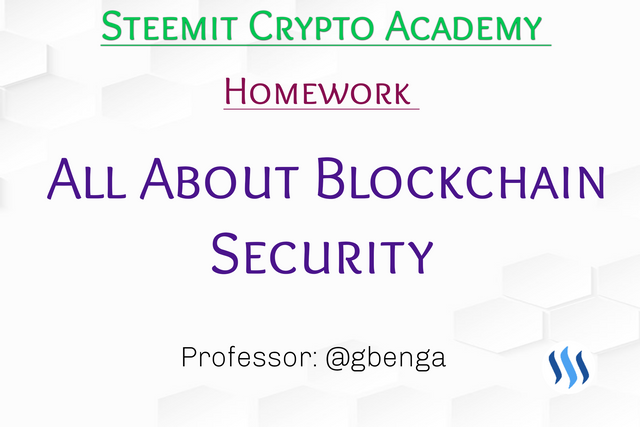ALL ABOUT BLOCKCHAIN SECURITY - 51% ATTACK

INTRODUCTION
Generally, blockchain technology is quite secure. This is because, data is shared across several computers on various nodes eliminating the possibility of a single point failure. Also, the underlying mechanism such as game theory which backs the technology makes it extremely difficult to be penetrated. Yet still, it still comes with several vulnerabilities which various tech hijackers and fraudsters crave to exploit.
In this article, I will be tackling a very pressing issue that blockchains have been fighting to combat. This is the issue of 51% attack.

CONCEPT OF 51% ATTACK
Like any public company that has a board of shareholders, whoever owns the majority stake in the company steers its affairs. Similarly, due to the decentralized nature of public blockchains, miners have the responsibility of creating blocks to validate various transactions happening throughout the network. As such any entity or group which dominates more than half of its block production (hash power) controls the majority of the blockchain.
Hackers with great resources at their disposal can therefore take absolute control of the network if they can produce more than 50% of mining blocks, hence 51% attack. And since the sole job of miners is to validate transactions that prevent tampering, block creation and validation can be prevented altogether.
51% attacks can happen on any public blockchain which is why it is essential to have a team of miners, representatives or witnesses working round the clock to prevent this. Such crisis result in various adverse effects. These include; double spending of coins, hindering transaction and preventing block creation.

EFFECTS OF 51% ATTACK
One a hacker group controls majority of the blockchain's operations, its network is prone to a variety of alterations and tampering altogether. Here are some adverse effects of this form of attack;
Prevent Block Creation : Miners are supposed to work round the clock to ensure that there is enough blocks on which transactions are validated in order to be issued to the blockchain network. But after a 51% attack, the hackers who now control the mining operations can decide to halt block creation altogether there by seizing transactions in the process.
Double Spending Tokens : Since the hackers now controls that validation of various transactions as a majority block producer, they can simply reverse any sent payments/tokens which will be as if they never left. This is quite effective because they are now in charge of validating transactions which were never placed on the ledger. And since there is no central authority to oversee their work now, they can simply get away with this.
Hindering transactions : Since mining works with the proof of work technology and rewards the first miner to validate the transactions, these form of hacks exploit this avenue. What happens is that they can completely block other miners from validating transactions altogether in order to validate the most transactions first. This therefore becomes very profitable after a short period for those responsible.

51% ATTACK SOLUTIONS
- Secure Blockchain's Backing Protocol : The goal of these hackers is to collect as much hash power as they can in order to be the sole majority. This is why such attacks usually target small scale blockchains. For a blockchain to be secure, there must be a strong backing protocol with all the necessary oversight in place to identify possible weakness.
- Sizeable Mining Pool Sizes : Mining pools provide the avenue for miners to combine their hash powers to effectively mine crypto in order to maximize their earning potential on generated tokens. The bigger the pool, the more prone it is to 51% attacks. This is why large mining pools like Ghash.io have reduced their pool size to about 30% hold of Bitcoin as of January 2019.
PERSONAL EXPERIENCE
Since this form of security threat is associated with blockchain networks, I personally do not have experience with them but I have read a few articles on this matter.
Bitcoin Gold : In May 2018, hackers exploited bitcoin gold for over $18m through the double spending technique. The attempt was a great success and was done by an unknown and malicious party.
Feathercoin : This is a clone of Litecoin which had 16,000 coins that were double spent back in 2013 at a time when it was doing quite well on the markets.

CONCLUSION
Any public blockchain is susceptible to a 51% attack. However, the risk is reduced when a majority of the hash power is diversified and has several expert oversight on its operation. This is why fully fledged networks like Bitcoin and Ethereum are less prone to these attacks than that of altcoins.
Thank you for your attention.
I would appreciate your thoughtful contributions in the comment section as well. Thank you for your atttention.

Many thanks to the steemit team (@steemcurator01 & @steemcurator02) for this initiative.
To the attention of professor @gbenga
51% attack is often used by bad actors especially when a protocol is about to be introduced into the blockchain or so as to affect nodes and start to double spend.
Rating 7
Twitter Share: https://twitter.com/bananmuni/status/1370345228910084098?s=19
I had the idea about the 51% share ensure the shareholders could make a decision from the end of the voting of majority. but in case of block producing it is also a similar way as he explained that 51% producers can have the influence and impact on the blockchain. and 3 more issues you have covered very nicely what they can do in terms of block producing like Prevent Block Creation, Double Spending Tokens, Hindering transactions
That a very thoughtful contribution from you @engrsayful. Thank you.